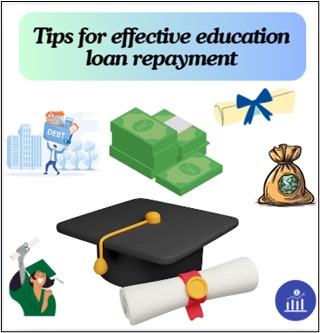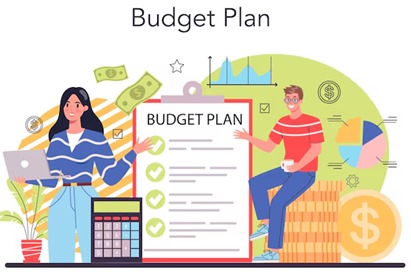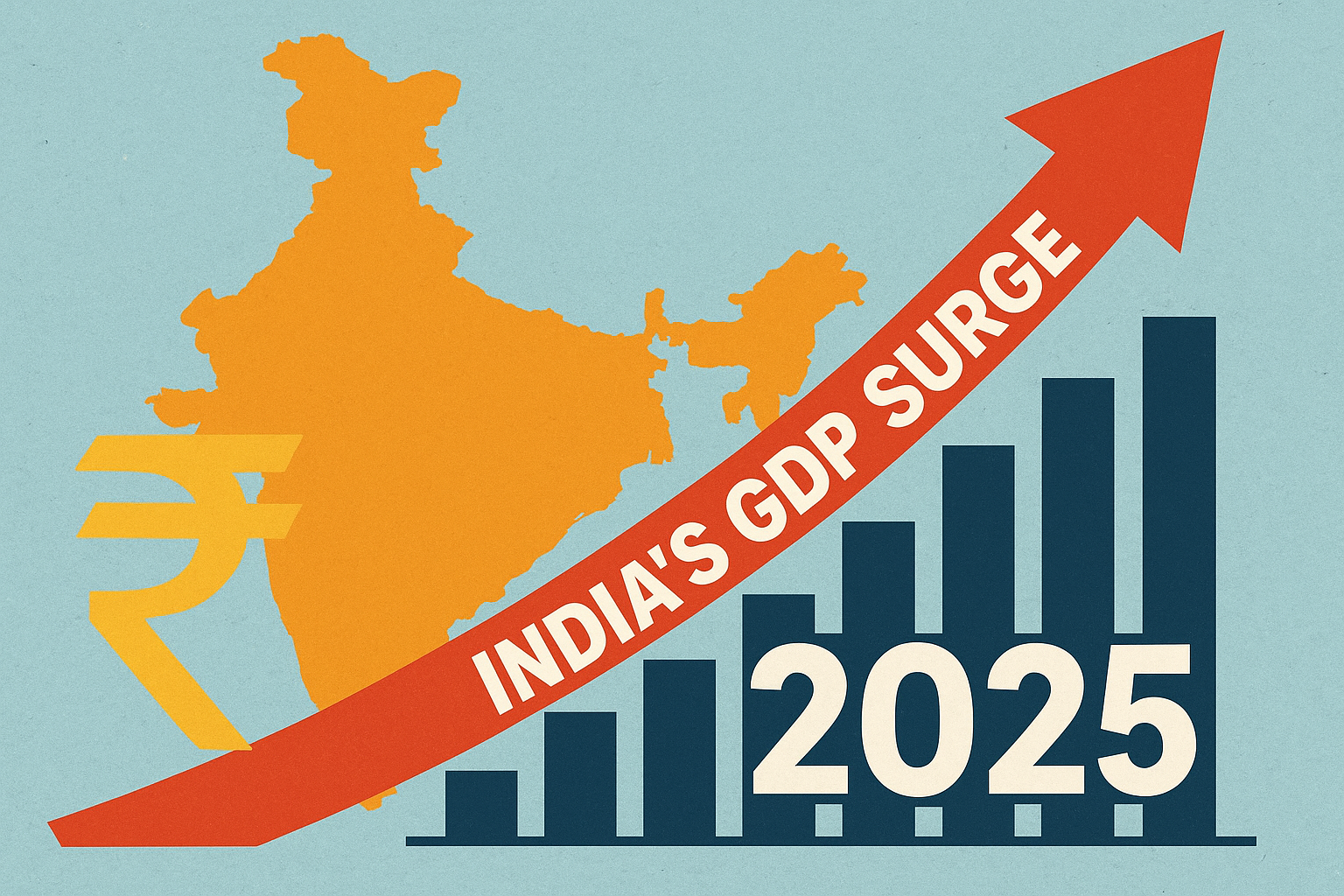Table of Contents
Explore some easy tips to manage your education loan repayment effectively.
Education is the most crucial investment in a human’s life. It helps a person to evolve into a better version, earn more, support their family, contribute substantially, etc. However, the ever-growing inflation, competition and population have led to a humongous increase in the cost of education.
Due to this, the need for education loans has increased in recent years. In India, from December 2020 to 2022 the education loan disbursement increased by 54.3%. Students willing and capable of higher education take loans to avoid the one-time burden of such costs on them or their parents.
Education loans are debt assistance provided by banks and financial institutions. It is according to the fees and expenses of a particular course/degree. Its interest, repayment, and types differ from institution to institution.
However, people with comparatively less financial literacy fear taking debt of such a large amount. In their opinion, repayment of such loans would cost them more than their actual loan. This myth should be broken.
Education is the fundamental right of every individual, and if any student is willing to pursue higher education, an education loan is the easiest option for them. Its repayment doesn’t cost much if it is planned effectively. Read more to explore some methods and tips for education loan repayment.

Education Loan Repayment: A Comprehensive Guide
Education loans are a valuable financial tool for students pursuing higher education in India. However, managing the repayment process effectively is crucial to avoid financial strain and make the most of this investment.
Here’s a comprehensive guide to help you navigate the education loan repayment landscape:
Understanding Education Loan Repayment
- Repayment Structure: Education loans typically have a grace period of 6 months to 1 year after completing your course before you need to start repaying. The repayment tenure can range from 5 to 15 years, depending on the lender and loan amount.
- Interest Calculation: Interest on education loans is usually calculated on a reducing balance method, meaning the interest is charged on the outstanding loan amount.
- Repayment Options: You can choose between monthly, quarterly, or half-yearly repayment schedules to suit your financial convenience.
Effective Education Loan Repayment Strategies
- Plan Ahead: Create a detailed repayment plan as soon as you receive your loan. Consider your income, expenses, and other financial commitments to determine the optimal repayment schedule.
- Make Extra Payments: Whenever possible, make additional payments towards your loan principal. This can significantly reduce the overall interest cost and shorten the repayment tenure.
- Utilize Tax Benefits: Take advantage of the tax benefits available on education loan repayments in India. Under Section 80E of the Income Tax Act, you can claim a deduction of up to ₹1.5 lakh on the interest paid on your education loan.
- Consider Loan Refinancing: If you find the interest rate on your existing loan to be high, explore refinancing options. Refinancing involves obtaining a new loan at a lower interest rate to pay off the existing loan.
- Manage Your Finances Wisely: Develop a sound financial plan to manage your expenses and avoid unnecessary debt. Budgeting your income effectively and tracking your spending can help you stay on top of your loan repayments.
Education Loan Repayment Rules in India
- Grace Period: The grace period for education loan repayment is typically 6 months to 1 year after course completion. However, some lenders may offer longer grace periods in certain cases.
- Interest Rates: Interest rates on education loans vary depending on the lender, loan amount, and borrower’s profile. They can range from 6.5% to 11% per annum.
- Repayment Tenure: The maximum repayment tenure for education loans is generally 15 years. However, it can be shorter or longer depending on the lender and loan amount.
- Prepayment Charges: Some lenders may levy prepayment charges if you repay the loan before the end of the agreed tenure.
SBI Education Loan Repayment Rules
- Grace Period: SBI offers a grace period of up to 1 year after course completion for education loan repayment.
- Interest Rates: SBI’s education loan interest rates start from 6.65% per annum.
- Repayment Tenure: The maximum repayment tenure for SBI education loans is 15 years.
- Prepayment Charges: SBI does not charge any prepayment penalty for education loans.
Methods
- Equated Monthly Instalments (EMIs)
It is the combination of principal and interest for every month. Usually, students prefer this method. To calculate EMIs for a particular loan, we need interest rate, loan amount, and number of instalments (months). For example,
A student took a loan of ₹40,00,000 at 9%. Its repayment should be done in 20 years, which means 240 months. The monthly instalment would be ₹35,989.
Moreover, there are online calculators for calculation on EMI.
- Part-payments
In this method, students can pay a lump-sum amount at some intervals. It is one of the most efficient ways to repay the loan early. Some banks charge fees for this method. However, students willing to opt for part-payments should have an amount considerably more than the EMI amount of that loan.
- Prepayment
A student can eliminate the burden of compounding interest on the loan by paying it in one go. It needs one to accumulate a large sum. Moreover, banks charge some processing fees for this prepay or foreclosure.
Plan for educational loan repayment
- Pre-plan your loan repayment.
The student should plan at least some initial years of loan repayment. The EMIs should be calculated, and the source for this repayment should be sought out. Moreover, one should understand that regular repayment would decide his/her credit score. It further helps that individual in getting any other loan in future. Students should go the extra mile to stay updated with any waiver, scholarship, new rules, etc, regarding the loan payment.
- Set you budget
While pre-planning for the loan repayment, one should be financially disciplined. Plan your monthly expenses accordingly by considering the EMI for student loans. Moreover, this budgeting would also help one to save money and invest or pay more in some instalments. It would reduce the obligation gradually.
- Auto payment of instalments
The bank provides a facility of ‘standard instruction’, which deducts the EMI amount from the particular account on a given date every month. This is extremely useful, in a busy schedule, one may miss the payment otherwise. Moreover, it has a psychological effect on the student. When he/she is aware of this fixed monthly expense of EMI, one would save more to facilitate it.
- Interest first
Students should aim to pay education loan interest first to avoid the compounding effect of it. Moreover, some institutions offer a moratorium period from the loan disbursement date to the first instalment date. During this period, instalment payment is not mandated, but the interest is charged. So, students should start paying these interest amounts to avoid overburdening after the instalments start.

- Only go for a fixed interest rate.
There are two types of interest- fixed and variable (floating). Students have the flexibility to select between them and also switch to another during the loan period. Floating interest is based on the repo rate of RBI. However, it is risky to opt for floating rates.
Fixed rates provide an easy and definite obligation towards repayment. It helps one to plan for such an obligation.
- Repay extra in a go.
It is one of the easiest ways to pay the education loan as early as possible. The student should first ascertain the amount of EMI he/she is paying. Then, some portion of the remaining income should be invested regularly in a high-paying instrument like mutual funds by systematic investment plan (SIP). Over a year, these SIPs would mature to generate good returns with the interest. The amount can pay a large chunk of the loan’s principal and reduce the base of interest %. Moreover, it is advisable to keep this investment separately and invest money for any uncertain expenses in future.
- Actively look for subsidies.
The government rolls out various schemes for students. Among these, some subsidies and scholarships are provided for virtuous students. Public sector banks also offer waivers, delayed payment and other financial assistance for underprivileged students or students in reputed universities. The Indian government has also launched a portal for student loan assistance, known as Vidya Lakshmi portal, where students can compare loans, calculate obligations, stay updated about new schemes, etc.
- Transfer loan to a new lender
Some banks offer the facility of transferring the loan from one lender to another. One of the most crucial objectives of this is to avail lower interest rates after some years of loan repayment. It helps an individual to repay the loan faster.
- Use the tax benefit.
The interest paid on the education loan can be fully deducted while paying the income tax under Section 80E of the Income Tax Act 1961. Students can use this opportunity to decrease their tax obligations.
- Earning during the education
An individual can work part-time while pursuing higher education to earn and pay at least the interest in that moratorium period. Moreover, we live in the era of the internet. One can learn new skills online, find a part-time job online, freelance online, and earn enough to start saving for loan repayment after the studies. It would also help the student to earn new skills and gain real-world experience.

Addressing “NPB Repayment” in Education Loans
NPB stands for Non-Performing Assets. In the context of education loans, it refers to loans where the borrower has not made any payments for a specified period, typically 90 days or more.
Incorporate NPB Repayment into your content by discussing the following:
- Consequences of NPB: Explain the potential consequences of not repaying your education loan, such as damage to credit score, legal actions, and difficulty obtaining future loans.
- Prevention Strategies: Provide tips on how to avoid NPB, such as creating a budget, setting up automatic payments, and seeking assistance from lenders if you’re facing financial difficulties.
- Recovery Options: Discuss the options available to lenders to recover the loan amount, including legal proceedings and asset seizure
Conclusion
Education should not be obstructed by financial hurdles. Thus, education loans are crucial. Its repayment would be easy if proper planning is done. The student should actively find ways to repay the loan in the minimum number of years. Moreover, education loan repayment tax benefits, subsidies, waivers, etc, are all added perks of effective planning.
What is the grace period for education loan repayment?
The grace period for education loan repayment is typically 6 months to 1 year after completing your course. This allows you to focus on finding a job and starting to earn before you begin making loan repayments. However, some lenders may offer longer grace periods in certain cases.
How can I calculate my education loan EMI?
You can use an education loan EMI calculator to estimate your monthly repayments. These calculators typically require you to input the loan amount, interest rate, and loan tenure. The calculator will then calculate your monthly EMI. Alternatively, you can use the following formula:
EMI = [P * R * (1+R)^N] / [(1+R)^N – 1]
where:
P = Principal loan amount
R = Monthly interest rate (annual interest rate divided by 12)
N = Number of monthly installments
What are the tax benefits for education loan repayment?
Under Section 80E of the Income Tax Act, you can claim a tax deduction of up to ₹1.5 lakh on the interest paid on your education loan. This means you can reduce your taxable income by this amount, leading to lower tax liability.
Can I prepay my education loan without any charges?
While some lenders may charge a prepayment penalty, many others allow you to prepay your education loan without any additional fees. It’s essential to check with your lender’s specific terms and conditions regarding prepayment charges.
What happens if I default on my education loan payments?
If you fail to make your education loan payments on time, it can have serious consequences. Lenders may charge late fees and interest penalties. In severe cases, they may take legal action, including repossessing assets or filing a lawsuit. Additionally, defaulting on your loan can damage your credit score,
DISCLAIMER: This article is not meant to be giving financial advice. Please seek a registered financial advisor for any investments.
- Make in India 2.0: How Manufacturing Is Reshaping Market Sentiment - December 13, 2025
- Real Estate Boom : Why Tier-2 Cities Are Attracting Big Investors - December 12, 2025
- India’s GDP Surge 2025: What the New Growth Numbers Mean for Markets - December 9, 2025





